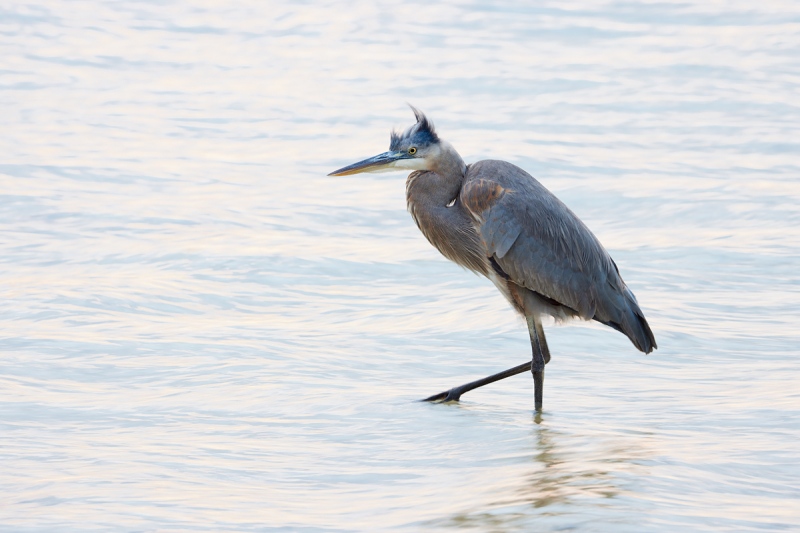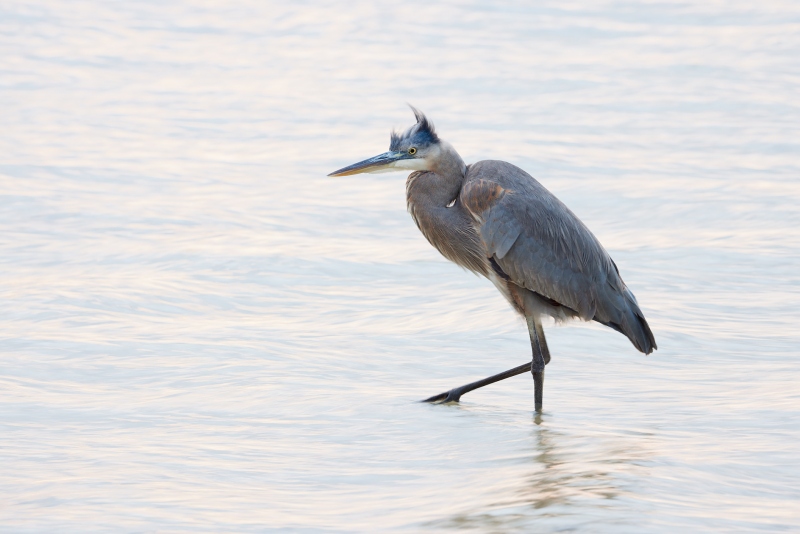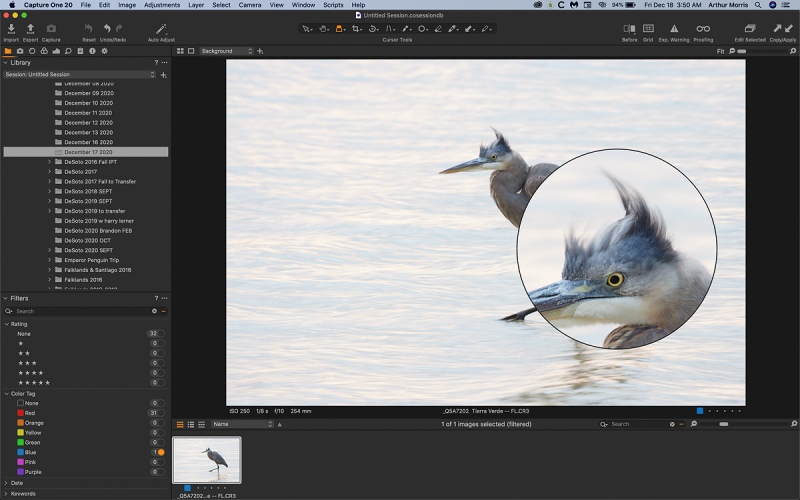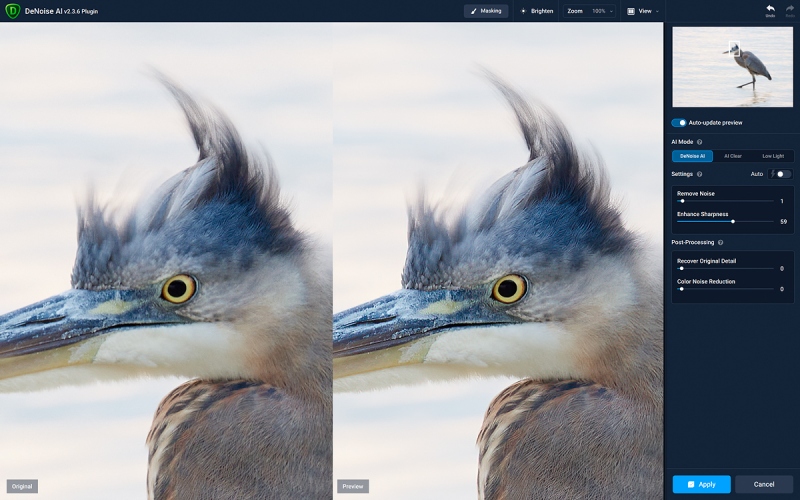What’s Up?
It was really cold on Thursday morning. And cloudy-dark early. There was one Willet on the sandbar. I left. There were three distant diving pelicans at my favorite back-up location. I left. I was glad that I did not have a client with me. Then it was off to back-up location #2 where there are usually lots of diving terns and pelicans. There was no bait in the water and thus no diving birds. At the end of the structure, I found a single, cold, immature Brown Pelican sitting on the railing. Taking advantage of the great IS systems of the Canon loaner gear (IS on the lens, and IBIS with the camera) and the outstanding close-focusing of the RF 100-500, I spent an hour doing pelican body-parts quasi-macro stuff. Trying to be creative. The good news is that I did not get my feet wet on a very cold for-Florida morning. I was done before 9am and then I headed back to my AirBNB to start work on the BAA Canon R5/R6 User’s e-Guide. I have lots of research to do on that. With wind again sun and clear skies, Thursday afternoon would have been a complete dud but for a single Reddish Egret photographed in very sweet light with the SONY 600 GM, the 1.4X TC, and the a7r IV. After two weeks with the Canon loaner gear it took me a few minutes to get comfortable with the SONY body.
R5s are really hard to get right now; Steve Elkins filled dozens of orders but the bodies from that shipment are all gone. Bedfords, however, is still the best place to get one. Many folks who had been on waiting lists at the big camera stores for many months were able to get an R5 from Steve last week and cancel their long-standing orders with the big guys. And everyone has been thrilled with Bedford’s service, the 3% discount, and the free second-day air shipping.
Canon R5/R6 AF e-Guide Info
So far, 40 folks have sent PayPals for their copy of the Canon R5/R6 AF e-Guide. And 21 who used my affiliate links to purchase their R5 have e-mailed for and received their free copy of the guide. If you e-mailed or sent a PayPal and did not receive your guide, please LMK immediately via e-mail.
Feedback has been overwhelmingly positive so far. Three folks wrote stating that they had a better way of setting up AF on their R5s. When I wrote back explaining why they were in error, two of them back-tracked. One stubborn guy is still doing it his way — less efficiently. Be sure to scroll down to read about my plans for a Canon R5/R6 User’s e-Guide. Understand that the info in the BAA Canon R5/R6 Autofocus e-Guide is so important that I opted to publish the AF guide immediately as the R5/R6 User’s Guide will take at least a month to finish.
BAA Canon R5/R6 Autofocus e-Guide
Twenty-one pages. 3,452 words. 28-DPP4 screen captures showing the R5’s vaunted AF system in action. Note: the AF system of the R5 is identical to the AF system of the R6.
You will learn:
1- The two most useful AF Methods for general bird photography and for birds in flight.
2- How to set up your R5/R6 AF Menus.
3- What boxes to check (and un-check) under Limit AF Methods.
4- How to change the AF Method quickly, easily, and efficiently. Note: the default way of doing this is clunky, cumbersome, and inefficient at best. One person replied that this tip alone was worth the price of admission.
5- The only setting that should be used for Initial Servo AF pt for Face Detection + Tracking.
I you are currently using multiple back buttons either for general bird photography or for birds in flight, what you learn in this guide will change your life. For the better.
Here are the first three paragraphs of this e-Guide:
From the moment I learned about the new Canon mirrorless bodies, I read about using two or three back-buttons to focus using different AF methods. The word on the street said that the way to go for birds in flight was to use one button to acquire focus with Zone AF or with Large Zone: Horizontal AF and then switch to another button to activate Face Detection + Tracking AF and then use the shutter button to make an image. My immediate thought was, “This is insanity! There has got to be a better way.” In short, there is a far superior way to set up AF on your R5 or R6.
Remember that I got away from any form of back-button or rear focusing many years ago after finally realizing that it is always easier to do one thing (press the shutter button), than it is to do two things (press a back button and then press the shutter button).
The default method of switching AF Methods with the R5/R6 bodies is cumbersome at best. It involves first pressing the grid button (my name) on the upper right back of the camera and then pressing the hard-to-access M-Fn button to toggle through the AF Methods. This method is so bad that it will not be mentioned again in this guide.
The guide is free to all who have ordered an R5 or an R6 using my B&H affiliate link or from Steve Elkins/Bedfords using the BIRDSASART coupon code at checkout. Please send your receipt to me via e-mail. It will take me a few days to a week to verify the B&H purchases. Bedfords folks should expect their free e-Guides fairly quickly.
To purchase your copy of the e-Guide, please send a PayPal for $25.00 to birdsasart@verizon.net and be sure to include the words R5/R6 AF Guide in your PayPal e-mail.
Everyone who gets the guide will receive a free update no later than the first week in January.
Canon R5/R6 User’s e-Guide
I am planning on doing a complete Canon R5/R6 User’s e-Guide. This will require a lot of research, a lot of time, and a lot of effort. I am hoping to have it complete by mid- to late January. As always, folks who use the BAA affiliate links to purchase their Canon gear will receive a substantial discount.
Understand that the info in the BAA Canon R5/R6 Autofocus e-Guide is so important that I opted to publish the AF guide ASAP.
Please Remember
With income from IPTs approaching zero, please, if you enjoy and learn from the blog, remember to use one of my two affiliate programs when purchasing new gear. Doing so just might make it possible for me to avoid having to try to get a job as a Walmart greeter and will not cost you a single penny more. And if you use Bedfords and remember to enter the BIRDSASART code at checkout, you will save 3% on every order and enjoy free second-day air shipping. In these crazy times — I am out at least forty to sixty thousand dollars so far due to COVID 19 (with lots more to come) — remembering to use my B&H link or to shop at Bedfords will help me out a ton and be greatly appreciated. Overseas folks who cannot order from the US because of import fees, duties, and taxes can always help out by clicking here if they see fit.
Great Topaz News!
Folks who use the BAA Topaz link to purchase Sharpen AI, DeNoise AI, or the Utility Bundle (or any other Topaz plugins) will receive a 15% discount by entering the ARTHUR15 code at checkout. To get the discount you must use my link and you must enter the discount code. Be sure to start with this link.
Topaz Stuff
As I said just a while back and have said often many times before, I should have listened sooner. If you, like me, are new to the Topaz party, please use this link to purchase. Right now I can wholeheartedly recommend both Topaz Sharpen AI and Topaz DeNoise AI. Though I have not yet worked with JPEGtoRAW AI or Gigapixel AI, I have installed both of these plug-ins and look forward to trying them on some I-Phone 11 images fairly soon. If you are thinking like me, consider the Utility Bundle that includes all four plug-ins mentioned above at a money-saving price.
Again, those who purchase Sharpen AI or DeNoise AI using my link, can e-mail to request a short Getting Started with Topaz e-Guide. I had a bit of trouble getting the two plug-ins installed and having them appear in the Photoshop Filter Menu. In addition, I will explain how to best learn about the two plug-ins by applying them on a Layer (in Photoshop).
New and Better Bedfords Discount Policy!
You can now save 3% on all of your Bedfords photo gear purchases by entering the BIRDSASART coupon code at checkout. Your discount will be applied to your pre-tax total. In addition, by using the code you will get 2nd day air shipping via Fed Ex.
Grab a Nikon AF-S Teleconverter TC-14E III and save $14.99. Purchase a Canon EOS R5 and your discount will be $116.97. Purchase a Sony FE 600mm f/4 GM OSS lens and save a remarkable $389.94! Your Bedford’s purchase no longer needs to be greater than $1,000.00 for you to receive a discount. The more you spend, the more you save.
Money Saving Reminder
Many have learned that if you need a hot photo item that is out of stock at B&H and would enjoy free overnight shipping, your best bet is to click here, place an order with Bedfords, and enter the coupon code BIRDSASART at checkout. If an item is out of stock, contact Steve Elkins via e-mail or on his cell phone at (479) 381-2592 (Central time). Be sure to mention the BIRDSASART coupon code and use it for your online order o save 3% and enjoy free 2nd-day air shipping. Steve has been great at getting folks the hot items that are out of stock at B&H and everywhere else. The wait lists at the big stores can be a year or longer for the hard to get items. Steve will surely get you your gear long before that. For the past year, he has been helping BAA Blog folks get their hands on items like the SONY a9 ii, the SONY 200-600 G OSS lens, the Canon EOS R5, the Canon RF 100-500mm lens, and the Nikon 500mm PF. Steve is personable, helpful, and eager to please.


Gear Questions and Advice
Too many folks attending BAA IPTs and dozens of photographers whom I see in the field and on BPN, are–out of ignorance–using the wrong gear especially when it comes to tripods and more especially, tripod heads… Please know that I am always glad to answer your gear questions via e-mail. Those questions might deal with systems, camera bodies, accessories, and/or lens choices and decisions.
|
|
|
This image was created on 17 December 2020 near Fort DeSoto Park. I used the handheld Canon RF 100-500mm f/4.5-7.1L IS USM lens (at 254mm) and the highly touted 45MP Canon EOS R5 Mirrorless Digital camera body. ISO 250. Exposure determined by the histogram, experience, and luck, and confirmed as perfect by RawDigger: 1/8 sec. at f/10 in Manual mode. AWB at 5:25pm on a cloudy-dark afternoon. Face Detection + Tracking/AI Servo AF was active at the moment of exposure and performed to perfection; the active AF point tracked and nailed the bird’s eye. Click on the image to see a larger version. Image #1: Great Blue Heron and gently moving wavelets |
5-stops of Image Stabilization (IS)
Traditionally, if you want to try to blur slowly moving water, you need to be on a tripod. But I love the light weight of the R5/100-500 RF rig and tremendously enjoy the freedom that comes with handholding. So with this somewhat drab subject, I tried working first at 1/15 sec. and then at 1/8 second. The first few images looked pretty sharp on the back of the camera … Scroll down to check out the sharpness in Images 1C and 1D.
I was seated with this bird using the knee-pod technique. I stayed with the bird for nearly an hour hoping that the sun would appear in the narrow light window just above the horizon and yield a spectacular red sunset. But alas, the dark heat clouds lowered and put an end to my hopes. With Image #1, I do like the effect of the gently moving water created with the very slow shutter speed of 1/8 second.
The rule for handholding (before IS) was to use a fraction of one over the lens length to figure the minimum shutter speed needed to create a sharp image. For this image that would be 1/254 which rounds off nicely to 1/250 sec. Starting at 1/8 second the math looks like this: 1/8, 1/15, 1/30, 1/60, 1/125, 1/250. From 1/8 to 1/250 is five stops. The RF 100-500 is supposed to offer five stop of image stabilization and the additional IS provided by the R5’s IBIS(in-body image stabilization) system surely did not hurt.
I am getting better with R5 exposures; RawDigger showed this one to be slightly less than 1/3 stop under-exposed. Image #1 above depicts the optimized image pretty much as it looked in camera. After converting the image in Capture One the only thing that I did in post was to run Topaz DeNoise AI on the whole image. See below for more on that.
|
|
|
This image was created on 17 December 2020 near Fort DeSoto Park. I used the handheld Canon RF 100-500mm f/4.5-7.1L IS USM lens (at 254mm) and the highly touted 45MP Canon EOS R5 Mirrorless Digital camera body. ISO 250. Exposure determined by the histogram, experience, and luck, and confirmed as perfect by RawDigger: 1/8 sec. at f/10 in Manual mode. AWB at 5:25pm on a cloudy-dark afternoon. Face Detection + Tracking/AI Servo AF was active at the moment of exposure and performed to perfection; the active AF point tracked and nailed the bird’s eye. Click on the image to see a larger version. Image #1A: Great Blue Heron and gently moving wavelets — juiced-up version |
Hoping for a Great Sunset
Since my hopes for a great sunset had been dashed, I decided to create a juiced up version with more color in the water and a bit more contrast.
Please leave a comment and let us know which of the two versions you prefer and why you made your choice.
|
|
Image #1C: Capture One screen capture |
Capture One Screen Capture (C-1)
I was quite surprised when I put the C-1 loupe on the bird’s eye and found that virtually every horizontal image made at 1/8 second was very sharp on the eye (as long as the bird was not moving). The wind on Thursday evening was from the west. So when the bird turned away from the wind, the crest feathers fluffed up a bit. Working at 1/8 second, I knew that the crest feathers would be slightly blurred. And they were. And their is a slight moving water blur above the raised far-foot. Who would have ever thought that you could consistently create sharp-on-the eye images at 1/8 second with a super-telephoto zoom lens?
When I created some verticals, very few of the images were sharp, possibly because holding the lens still is more difficult with the camera turned on end (without a vertical grip), or possibly because I was working at somewhat longer focal lengths of from 300 to 350mms on average. My suspicion is that the former reason was the main cause as I remember having trouble keeping the lens still when creating the verticals.
|
|
|
Be sure to click on the image to view it larger. Image #1D: Topaz DeNoise AI on Auto on the Great Blue Heron and gently moving wavelets image at 100% |
Topaz DeNoise AI on the Great Blue Heron and gently moving wavelets image
With this image, Topaz DeNoise AI on Auto has taken a pretty much perfect, nearly noise-free image and made it just a little bit cleaner and a good bit sharper. Notice the super-low Reduce Noise value of 1. And enlarge the image to see the additional sharpness. I run DeNoise on virtually every image that I process.
Typos
Feel free to e-mail or to leave a comment regarding any typos or errors. Just be right :). with love, artie



















Tuanks Arthie inwill.orfer as soon.i hope if you will have some news about the setting you will send them as upgrade
Thanks
I ask your pardpn for wrong words..
Thanks Adamo..but using traking mode on shutter button sometime when there are more birds in the same situation..the camera works as it would like…
Using zone on shutter botton you are able to.put the af on the right subject…and then start with traking mode and eye detect by af button. Why it is no good ?
My way is far better, faster, and more efficient. Read what I wrote about the R5 AF e-Guide above. You might need to translate it to fully understand. You can get a copy of the guide using PayPal as above.
with love, artie
ps: assuming you speak Italian, this should help:
La mia strada è molto migliore, più veloce e più efficiente. Leggi quello che ho scritto sulla e-Guide di R5 AF sopra. Potrebbe essere necessario tradurlo per comprenderlo appieno. Puoi ottenere una copia della guida utilizzando PayPal come sopra.
con amore, artie
Arthie..i know you are the best. I have now r6 ( and also 1dxmark iii) but i am a bit in trouble to set ok a mirrorless.
A question before to buy your eguide. You wrote you are writing a new guide for jannuary. If i buy now the guide i will receive after tje.new too ?
Thanks
Gio
Hi Giovanni,
Thanks for your kind words. The AF Guide (available now) costs $25.00. The Complete Camera User’s Guide will cost $60.00. Folks who purchase the AF Guide will get a $20 discount on the complete guide (when it becomes available).
with love, artie
Ciao Giovanni,
Grazie per le gentili parole. La guida AF (disponibile ora) costa $ 25,00. La Guida completa per l’utente della fotocamera costerà $ 60,00. Le persone che acquistano la Guida AF riceveranno uno sconto di $ 20 sulla guida completa (quando sarà disponibile).
con amore, artie
Thanks Adamo..but usimg yraking mofe on shutter button sometime when there are more birds in the same situation..the camera works as it would like…
Using zone on shutter botton younare able to.put the af on tje roght subject…and then start with traking mode and eye detect by af button. Why it is no good ?
Steve at Bedford’s has been great and has secured both the hottest Sony and Canon gear for me and with the new 3% discount (boy, I wish that was available when I had bought all of my gear) there’s no excuse not to buy from him.
Glad to hear you are having fun with the R5/100-500 and I hope to make it out today before the snowstorm.
Hello
I need help with setting up the r5 / r6 with the new firmware
IF I set ” zone” as a default for Af and put the button behind it to activate eye search … when I press it, does the tracking mode (and face search) also activate?
Thanks
Don’t recommend setting up your camera that way for BIF. Follow Artie’s advice and tweak it from there to suit your needs.
Artie
Last week I purchased Topaz Denoise AI, using your link, I love it! Thank You, for the advice!
And the 15% savings.